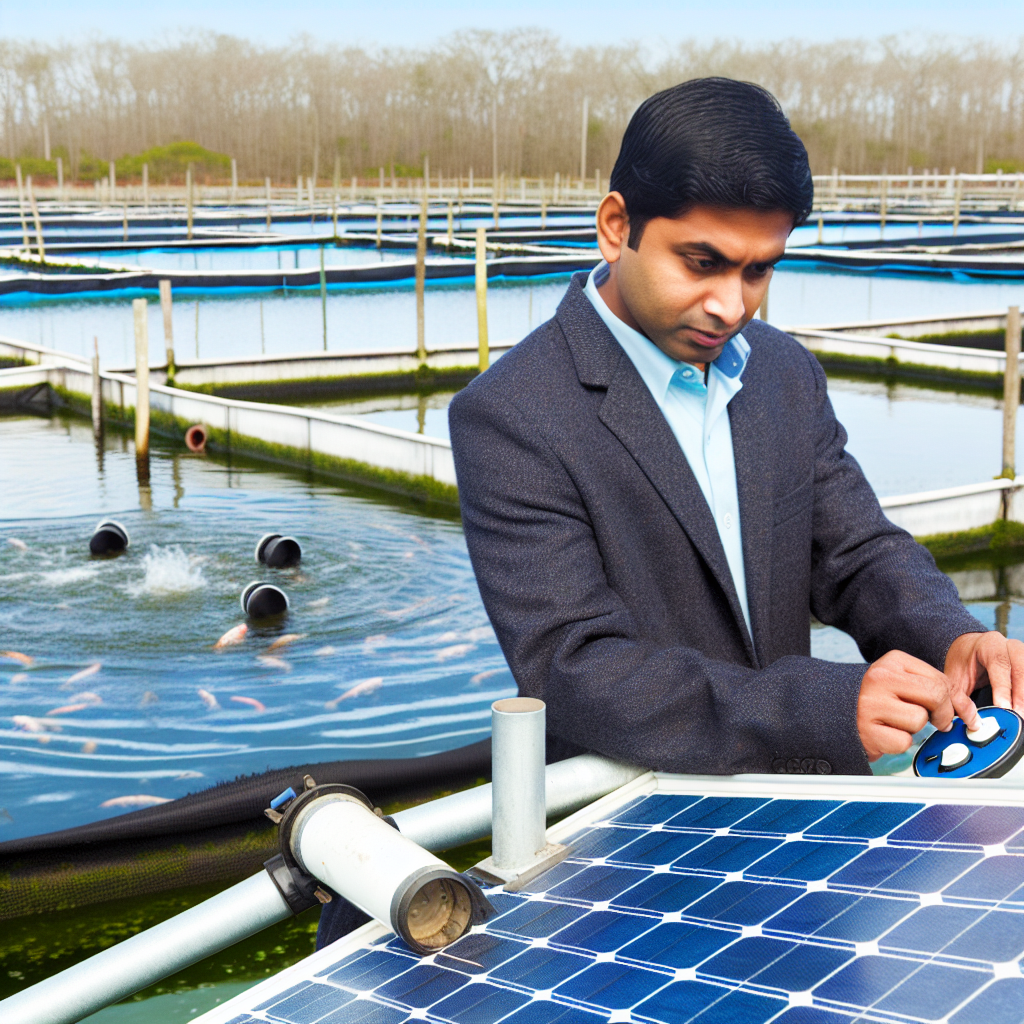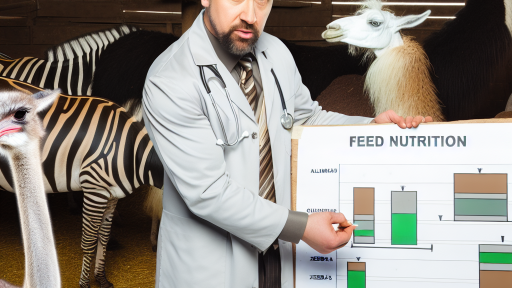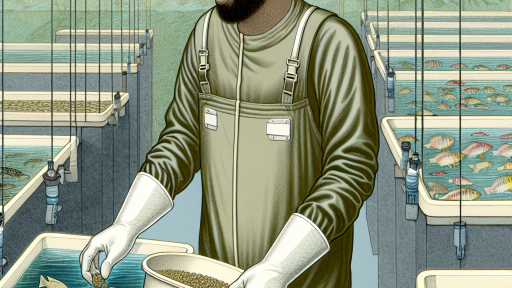Introduction to Sustainable Aquaculture
Sustainable aquaculture plays a vital role in food security.
It involves farming aquatic organisms in a responsible manner.
This method minimizes environmental impact while maximizing output.
More importantly, it ensures resources are conserved for future use.
Benefits of Sustainable Practices
Utilizing sustainable practices promotes ecosystem health.
These methods help maintain biodiversity in aquatic environments.
Additionally, they reduce reliance on wild fish populations.
Consequently, this approach supports community livelihoods effectively.
Energy Efficiency in Aquaculture
Energy efficiency is crucial for sustainable aquaculture operations.
Implementing energy-saving technologies can significantly reduce costs.
Moreover, it helps decrease carbon footprints associated with farming.
Investing in renewable energy sources enhances sustainability efforts.
Innovative Technologies
Advancements in technology are transforming aquaculture practices.
For instance, automated feeding systems optimize fish growth.
Furthermore, water quality monitoring systems ensure healthy environments.
Transform Your Agribusiness
Unlock your farm's potential with expert advice tailored to your needs. Get actionable steps that drive real results.
Get StartedThese innovations lead to more efficient resource use overall.
Community Engagement
Engaging local communities fosters sustainable aquaculture development.
Participatory approaches encourage knowledge sharing and innovation.
Thus, communities become active contributors to sustainability efforts.
Ultimately, this collaboration enhances the resilience of aquaculture systems.
Understanding Energy Efficiency in Aquaculture Systems
Defining Energy Efficiency
Energy efficiency refers to using less energy while achieving the same output.
It reduces energy waste and lowers operational costs.
Efficient systems improve sustainability in aquaculture practices.
Importance of Energy Efficiency in Aquaculture
Energy efficiency is crucial for reducing carbon footprints.
It helps aquaculture operations become more competitive.
Moreover, it enhances the resilience of fish farming communities.
Typical Energy Consumption in Aquaculture
Aquaculture systems often consume energy for various processes.
Water circulation, aeration, and heating are primary energy users.
Facility lighting and feeding systems also require significant energy.
Current Trends in Energy Efficiency
Many aquaculture operators are adopting renewable energy sources.
Solar panels and wind turbines provide eco-friendly alternatives.
Energy-efficient appliances are increasingly used in aquaculture operations.
Strategies for Improving Energy Efficiency
Implementing smart technologies can significantly enhance energy efficiency.
Automation controls optimize resource usage in aquaculture systems.
Periodic audits identify energy-saving opportunities in operations.
- Upgrade to energy-efficient equipment to reduce consumption.
- Implement advanced monitoring systems for real-time energy tracking.
- Train staff on best practices for energy management.
Case Studies on Energy-Efficient Practices
Numerous aquaculture farms have successfully implemented energy-efficient practices.
For instance, GreenWave Aquaculture reduced energy use by 30%.
They installed LED lighting and improved insulation in their facilities.
- Bluefin Farms integrated solar panels, dramatically cutting energy costs.
- Ocean Harvest Innovations used heat exchangers to enhance heating efficiency.
Renewable Energy Sources for Aquaculture
Solar Energy Solutions
Solar energy provides a clean and abundant source of power for aquaculture operations.
Showcase Your Farming Business
Publish your professional farming services profile on our blog for a one-time fee of $200 and reach a dedicated audience of farmers and agribusiness owners.
Publish Your ProfilePV panels convert sunlight into electricity, reducing reliance on fossil fuels.
Moreover, solar-powered systems can operate water pumps and aerators efficiently.
Implementing solar technology lowers operational costs in the long run.
Additionally, solar energy systems are becoming more affordable every year.
Wind Energy Applications
Wind energy harnesses the power of moving air to generate electricity.
Wind turbines can be installed onshore or offshore, depending on local conditions.
These turbines generate clean energy, reducing greenhouse gas emissions.
Furthermore, wind energy complements other renewable sources for more reliability.
By adopting wind energy, aquaculture operations can help protect the environment.
Hydropower Utilization
Hydropower uses flowing water to generate electricity effectively.
It can power aquaculture facilities located near rivers or lakes.
This renewable source provides a consistent and stable energy supply.
Moreover, small-scale hydropower systems can be installed without significant ecological disruption.
Hydropower technologies are highly efficient, often converting more than 90% of energy.
Benefits of Using Renewable Energy in Aquaculture
Adopting renewable energy reduces operational costs in aquaculture systems.
It also decreases dependency on non-renewable resources.
Furthermore, using clean energy significantly lowers carbon footprints.
Renewable energy contributes to sustainable practices in the aquaculture industry.
This transition can enhance public perception and consumer support as well.
Find Out More: Technology Innovations in Livestock Transportation
Innovative Technologies: Recirculating Aquaculture Systems (RAS) for Energy Efficiency
Overview of RAS Technology
Recirculating Aquaculture Systems have revolutionized fish farming.
These systems optimize water use and reduce energy consumption.
Water is filtered and reused within the system, minimizing waste.
Key Components of RAS
RAS consists of several important components.
First, there is the biofilter, which removes harmful waste from the water.
Next, the sedimentation tank captures larger particles before recycling the water.
Additionally, oxygenation systems ensure fish receive adequate oxygen levels.
Energy Efficiency Benefits
Energy efficiency is a primary advantage of RAS technology.
These systems significantly decrease water and energy requirements.
Moreover, they utilize advanced pumps that consume less power.
This reduces the carbon footprint of aquaculture operations.
Case Studies of Successful RAS Implementations
Numerous farms have successfully implemented RAS technology.
For instance, AquaTech Farms reported a 40% reduction in energy costs.
They have also noted an increase in fish growth rates.
Another example is GreenSea Aquaculture, which minimizes water usage effectively.
Future Trends in RAS Development
The future of RAS shows great promise for innovation.
New technologies are emerging to enhance efficiency further.
For example, sensor technology enables real-time monitoring of water quality.
This allows for optimized management and improved fish health.
You Might Also Like: Selecting the Best Routes for Livestock Transport
Showcase Your Farming Business
Publish your professional farming services profile on our blog for a one-time fee of $200 and reach a dedicated audience of farmers and agribusiness owners.
Publish Your ProfileAquaponics as a Sustainable and Energy-Efficient Solution
Defining Aquaponics
Aquaponics integrates aquaculture and hydroponics into a single system.
This method features fish and plants growing together symbiotically.
Waste from fish provides nutrients for plants.
In turn, plants help filter and purify the water for fish.
Advantages of Aquaponics
Aquaponics presents multiple benefits for sustainable agriculture.
- It significantly reduces water usage compared to traditional farming.
- The system operates with minimal energy input.
- Aquaponics can produce food year-round, regardless of the season.
Energy Efficiency
Energy efficiency is a cornerstone of aquaponics systems.
These systems utilize natural processes to minimize energy consumption.
For example, they can use solar panels to power pumps and lights.
Thus, aquaponics can operate off-grid, cutting reliance on fossil fuels.
Environmental Impact
Aquaponics also positively affects the environment.
It reduces chemical runoff into local water bodies.
Moreover, it promotes biodiversity by supporting various species in one system.
As a result, aquaponics contributes to healthier ecosystems.
Implementing Aquaponics
Implementing aquaponics in communities has transformative effects.
Local schools and urban farms can adopt this method easily.
Education programs can teach community members about sustainable practices.
This fosters a culture of awareness and responsibility toward resource management.
Discover More: Innovative Technologies Transforming Modern Aquaculture

Best Practices for Reducing Energy Consumption in Fish Farming Operations
Implementing Efficient Equipment
Adopting energy-efficient equipment is crucial for sustainable aquaculture.
Invest in energy-efficient pumps and aerators to minimize energy use.
Consider solar-powered systems for outdoor operations.
Furthermore, regularly maintain all equipment to ensure optimal performance.
Optimizing Feed Management
Feed management significantly impacts energy consumption in aquaculture.
Utilize high-quality feeds that enhance growth rates and reduce waste.
Additionally, implement feeding strategies that prevent overfeeding.
Monitor fish feeding patterns closely to fine-tune feeding schedules.
Enhancing Water Quality Management
Maintaining optimal water quality reduces energy needs in fish farming.
Regularly test and monitor water parameters to ensure a healthy environment.
Employ efficient filtration systems to minimize energy costs.
Incorporating biological filtration can achieve better water quality naturally.
Utilizing Renewable Energy Sources
Incorporating renewable energy sources can drastically reduce energy costs.
Solar panels can power various aspects of aquaculture operations.
Wind energy is another viable option for fish farming operations.
By combining these sources, farms can achieve greater energy independence.
Training Staff for Energy Efficiency
Educating staff about best practices fosters a culture of sustainability.
Conduct training sessions on energy-saving practices regularly.
Involve employees in energy audits to identify savings opportunities.
Moreover, encourage suggestions from the team to improve energy use.
Monitoring and Evaluating Energy Use
Regular monitoring and evaluation of energy consumption help identify inefficiencies.
Use energy management systems to track electricity usage over time.
Showcase Your Farming Business
Publish your professional farming services profile on our blog for a one-time fee of $200 and reach a dedicated audience of farmers and agribusiness owners.
Publish Your ProfileSet energy reduction targets to motivate continuous improvement.
Additionally, analyze data to make informed operational decisions.
Delve into the Subject: Seasonal Care Tips for Sheep and Goats
Case Studies: Successful Implementation of Energy-Efficient Solutions in Aquaculture
Innovative Techniques in Energy Management
Aquaponics provides a synergistic approach to fish and plant cultivation.
This method minimizes energy consumption while maintaining productivity.
In New Zealand, GreenFish Farms successfully integrated renewable energy sources.
They used solar panels to power their operations.
This innovative technique reduced their carbon footprint significantly.
Efficiency Gains through Technology
Smart sensor technology optimizes water quality and energy use.
For example, AquaSmart Technologies implemented a monitoring system.
This system reduces energy costs by 30% in large aquaculture facilities.
Moreover, real-time data tracking enhances operational decisions.
Investing in advanced technology yields long-term benefits.
Case of Tilapia Farming in Florida
In Florida, AquaGreen Tilapia Farms adopted LED lighting in their tanks.
This saved both energy and costs associated with lighting operations.
As a result, they doubled their production while reducing energy use by 25%.
Additionally, the implementation of heat exchangers improved sustainability.
Such measures demonstrate the potential for efficiency in aquaculture.
Community Involvement and Training
Collaborative efforts enhance the knowledge base for energy efficiency.
In Vietnam, local aquaculture communities participate in training workshops.
These workshops focus on sustainable practices and energy-saving technologies.
Data indicates that participants improved their energy usage by 40%.
Community involvement fosters shared success and sustainability in practices.
Regulatory Support for Sustainable Practices
Governments play a crucial role in promoting energy-efficient solutions.
In Norway, subsidies for renewable energy systems boost aquaculture projects.
These incentives encourage farmers to adopt greener technologies.
As a result, many aquaculture systems now exceed regulatory energy standards.
This regulatory support creates a more sustainable industry overall.
Future Trends in Energy Efficiency for Sustainable Aquaculture
Innovative Technologies in Energy Management
Emerging technologies are revolutionizing energy management in aquaculture.
For instance, smart sensors can monitor energy consumption in real-time.
Additionally, automated systems optimize resource use according to demand.
This approach minimizes energy waste significantly.
Renewable Energy Adoption
Renewable energy sources are gaining traction in aquaculture settings.
Solar panels, for example, offer a sustainable power solution.
Wind turbines can harness natural wind patterns effectively.
Moreover, integrating these systems reduces reliance on fossil fuels.
Improved Circular Economy Practices
Integrating circular economy principles enhances sustainability.
These practices promote resource recovery and waste reduction.
For example, reusing nutrient-rich water supports fish health.
This strategy also cuts down on energy-intensive water treatment processes.
Showcase Your Farming Business
Publish your professional farming services profile on our blog for a one-time fee of $200 and reach a dedicated audience of farmers and agribusiness owners.
Publish Your ProfileCollaboration with Research Institutions
Partnerships with research institutions foster innovative solutions.
They can lead to the development of energy-efficient aquaculture practices.
Furthermore, joint projects often result in essential knowledge transfer.
This collaboration benefits the aquaculture industry as a whole.
Regulatory Frameworks and Incentives
Government regulations increasingly emphasize energy efficiency in aquaculture.
Incentives stimulate investment in energy-efficient technologies.
Such policies encourage adoption of sustainable practices at all levels.
Consequently, businesses can gain a competitive advantage through compliance.
Additional Resources
If done correctly, aquaculture increases food production, boosts …
Proposed solutions to anthropogenic climate change: A systematic …




